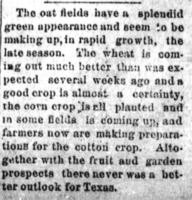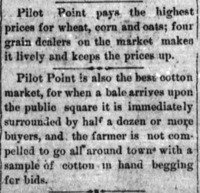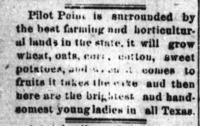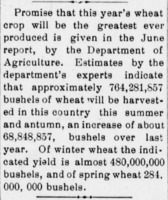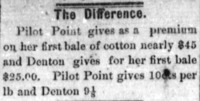Crops in Denton County
Below are several charts and newspaper clippings detailing the production of crops in Denton County and Pilot Point from 1870-1930. These can help to understand the agricultural production and context that Pilot Point and Denton County existed in. Through the charts below, it can be seen that Denton County produced cereal crops, cotton, potatoes, sweet potatoes, and peanuts. While other crops were farmed, their numbers paled in comparison to these crops. Additionally, the newspapers are able to provide a local context for these crops in and around Pilot Point. The local newspapers in Pilot Point promoted the production of these crops by detailing the value of them and possible profits for farmers who grew them. Additionally, ads promoting immigration to the Pilot Point area heralded the soil's quality and ability to grow these crops. Thus showing that farmers were inclined to grow these crops in the area.
The production of cereal crops aligns with Denton County residing in the Wheat Belt of Texas. Additionally, cotton was a staple in agriculture across the state, making its production in Denton County not surprising.
The production of wheat in Denton County increased through the turn of the 20th century, aligning with the trend in the state that wheat acreage and production increased as technology and machinery improved making wheat farming easier. Texas had three main wheat growing areas by 1919 -- North Central Texas, including Denton County, the Hill Country, and the High Plains. However, as changes came to agriculture, including irrigation and crop diversification, wheat production began to shift predominately to the High Plains region. This shift can be seen in the above charts as production fell following the turn of the 20th century.
Oats provided both a source of grains and winter pasture for farmers, and were thus a popular crop. Oat production in Texas peaked in 1919, which coincides with the chart above, showing that the trend could be seen in Denton County as well. Production remained high throughout the 1920s since oats were feed to all types of livestock and poultry. Again, this coincides with Denton County returns showing that the trend was true there in addition to the state at large.
Cotton was first grown by anglo farmers in Texas in 1821, and in 1852 Texas was the eigth largest producer of cotton in the U.S. However, the Civil War caused a decrease in production. Following the end of the Civil War, the introduction of barbed wire, and the expansion of railroads cotton production began to increase. Beginning in 1872, settlers began to come to the Blackland Prairie of Central Texas (including Denton County) and grow cotton. Cotton gins and cotton presses prepared cotton for market, and the relocation of presses to inland raillines allowed farmers to ship the cotton directly to consumers. Cotton was in high demand during World War I, but drops in prices following it caused many farmers to abandon farming and move to cities. Cotton production continued to decline after the 1920s as the government regulated cotton acreage, synthetic fibers were introduced, foreign production increased, and there was a lack of lint-processing in Texas.
Cotton production steadily increased in Denton County before reaching its peak in 1925. However, cotton production fell by nearly 50% from its 1925 level in 1930. Thus, while cotton may have held on longer in Denton County, it eventually caught up with the state trends by 1930.
Peanut farming was first introduced in Texas around 1906 with some of the largest peanut producing counties to the northeast of Denton County (including Fannin County). Following the depression of 1920-21 and the discovery that peanuts were poor feed for swine, peanut farming declined. By 1950, the primary peanut producing areas in Texas aside from East Texas were the Western crosstimbers found west and southwest of Fort Worth.
Peanut farming in Denton County rapidly expanded in the twentieth century and by 1920 had reached almost 60,000 bushels. However, in 1925, peanut production had declined by over 50%. This aligns with the larger trends in the state following the 1920-21 depression. Despite this, peanut production increased by 1930, and even surpassed the 1920 levels. This could be attributed to the large growth of peanuts in the Western crosstimbers. While Denton County may not have been in the Western crosstimbers to the west and southwest of Fort Worth, it certainly contained crosstimber regions that most likely would have been similar, and thus would have been good for peanut production.
Sweet potatoes were not grown commercially in Texas until the twentieth century. Even then, sweet potatoes did not reach peak production until 1927. During the 1920s and 1930s, sweet potatoes were the leading vegetable crop in the state, and Texas ranked second in the nation for sweet potatoe production. However, Denton County's sweet potatoe production when compared to that of the state at large is negligable. So, while Denton County produced sweet potatoes, it was not contributing to the state's production on a larger scale, and thus it can be assumed that they were used for local purposes.
Freedmen's communites across the state primarily focused on subsistance agriculture, however when growing cash crops they relied on cotton and sugar cane. Communities such as Grant's Colony, Mosier Valley, and Mudville grew cotton for these purposes. For food, these communities mainly grew sweet potatoes, peas, peanuts, and corn. As can be seen in Denton County, these crops were grown here as well, implying that members of St. John's would have grown similar crops.
Citations:
Atkins, Irvin M. A History of Small Grain Crops in Texas: Wheat, Oats, Barley, and Rye, 1582 - 1976. College Station: Texas Agricultural Experiment Station.; Handbook of Texas Online, Texas State Historical Association, "Cotton Culture," "Peanut Culture," "Sweet Potato Culture," http://www.tshaonline.org/handbook.


